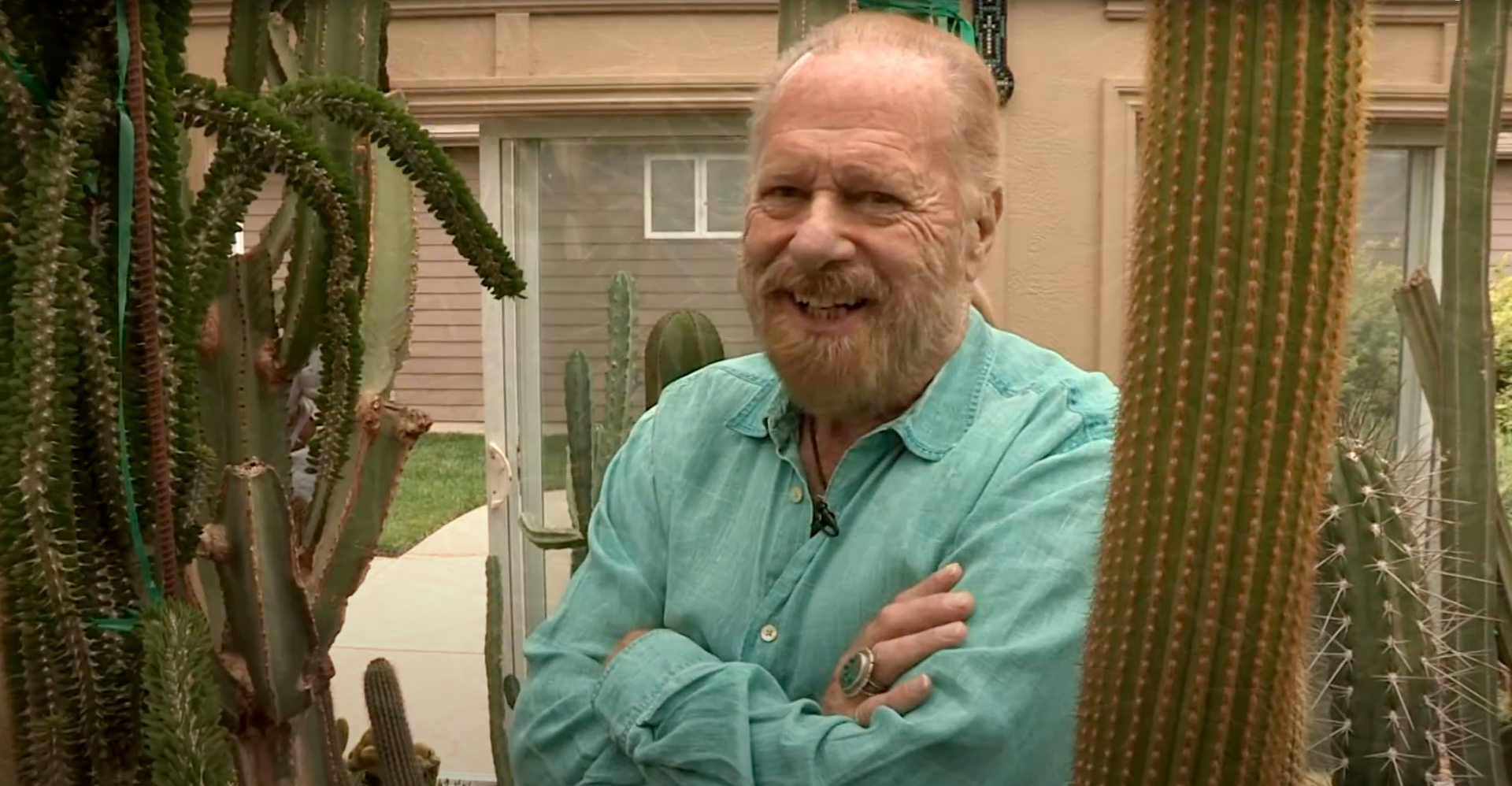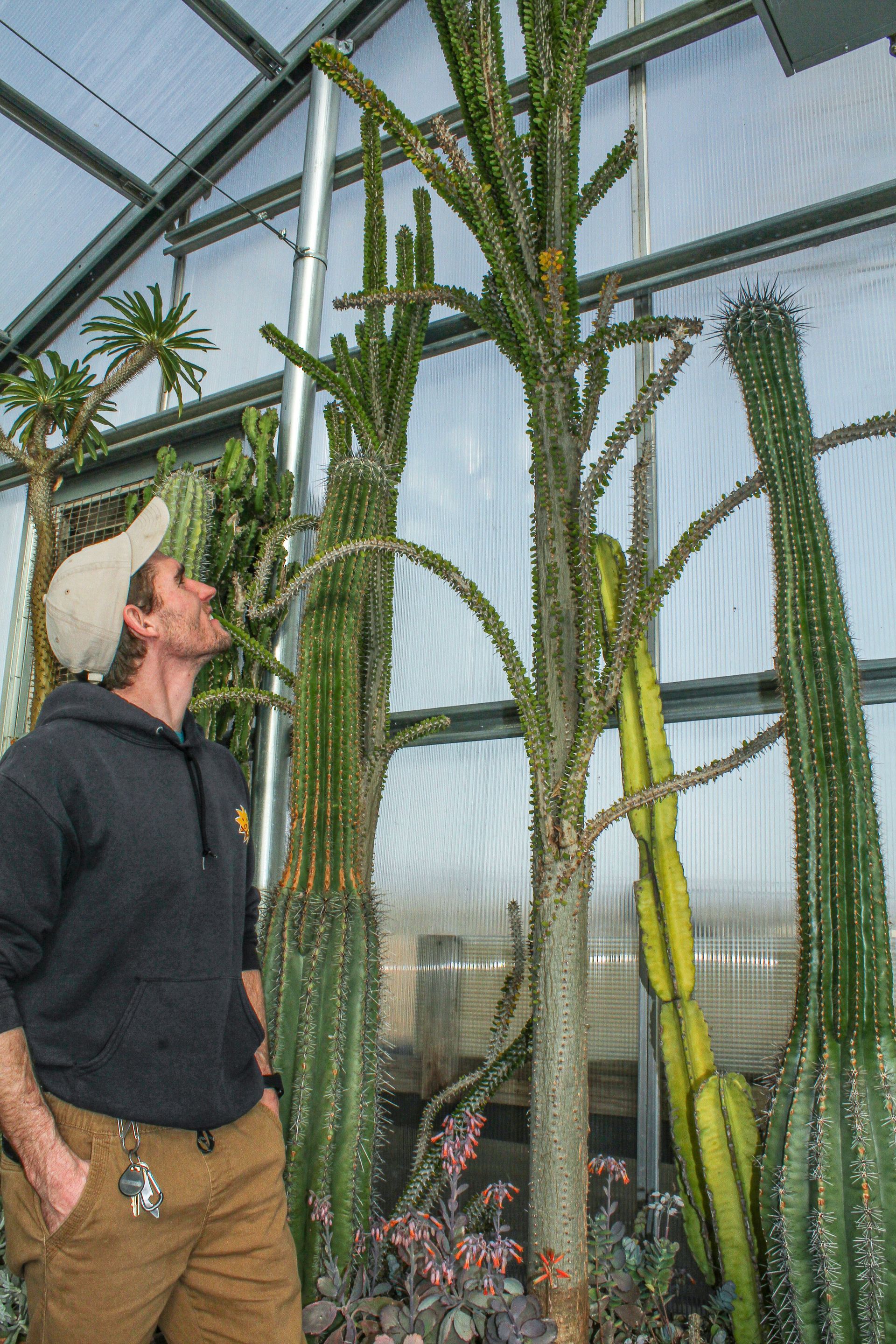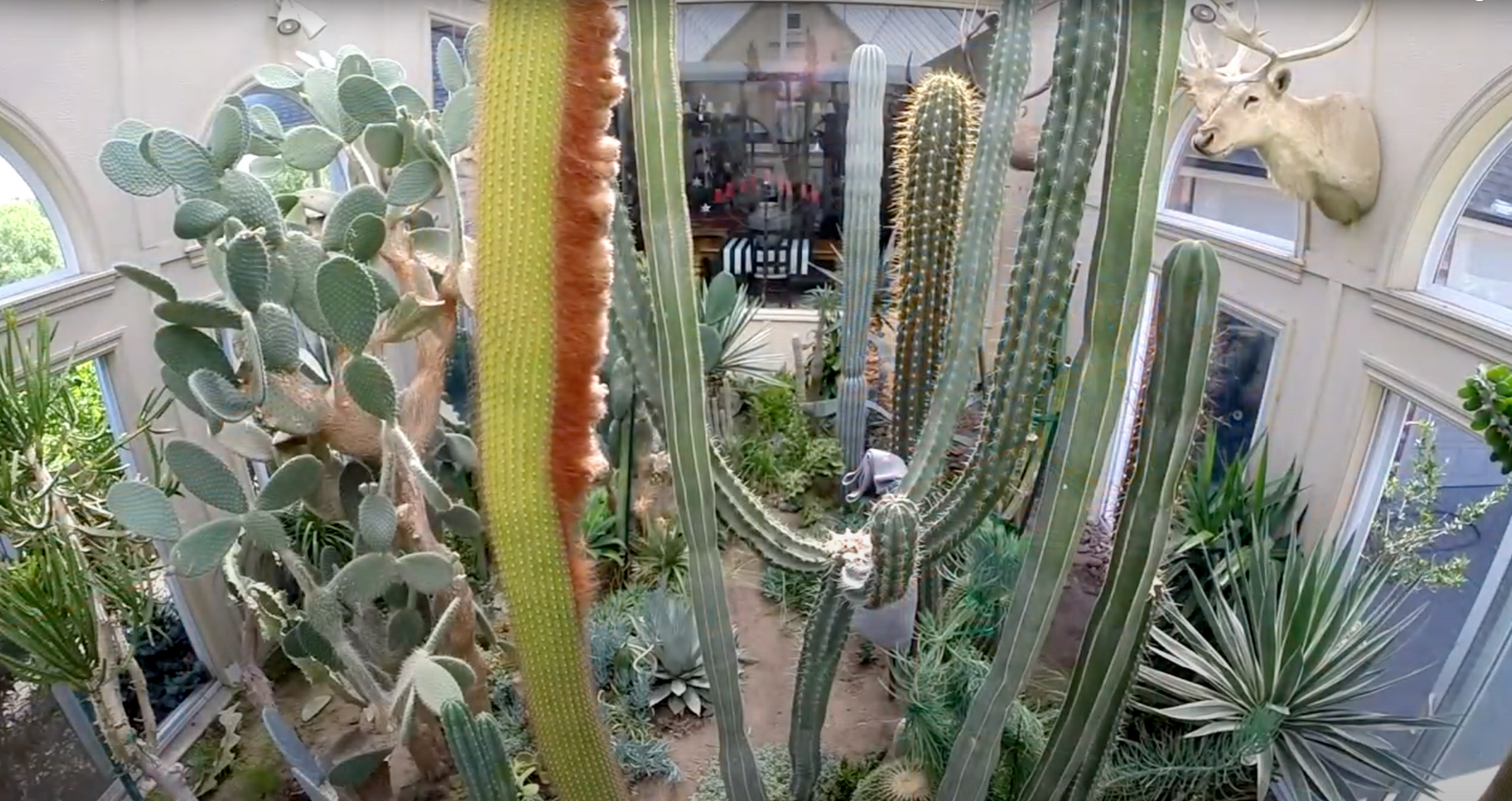Cactus Love
Wichitan’s Prickly Collection Lives On
Written by John Huthmacher
Wichitan’s Prickly Collection Lives On
Written by John Huthmacher

The late Ron Peake pictured with his cactus collection in 2014.

Sedgwick County Zoo horticulturist Tyler Seneff looks at cacti donated by the Peake family.

Builder Ron Peake constructed a greenroom adjacent to his dining room to house his extensive cactus collection.
As a successful architect and builder, Ron Peake was known for his “sharp” sense of style when it came to building homes.
A longtime Wichita resident who grew up in New Mexico, his design–build firm flourished, thanks to what his wife, Polly, described as an artistic eye for detail. Peake, a father of two daughters – Michelle Howard and Patricia Peake, both of Wichita – died at age 71 in November of 2018. He had amassed an eye-popping personal collection of cacti sourced over nearly four decades, primarily from greenhouses and desert plains in Arizona and New Mexico.
When constructing his dream home on Wichita's east side to accommodate his collection of cacti, he borrowed elements from an elaborate cactus garden incorporated into the design of The Phoenician, a luxury hotel resort located in Scottsdale, Arizona. Nestled comfortably in a thermostatically controlled environment, his cacti were lovingly arranged to complement one another, creating an eye-catching virtual desert display grounded in colorful shapes, sizes and textures.
"He just loved looking at them," Polly said. "He was a very visual guy, and being an architect and builder, he blended lots of different shapes and textures to make it more pleasing. He wasn't an expert; he just liked the look of them."
"A neighbor who was a doctor kept his surgical kit at home because Ron was always running over to get a piece of cactus pulled out of him." — Polly Peake, wife of the late Ron Peake
Today his donated collection has mostly been divided between the Sedgwick County Zoo in Wichita, and the Southcentral Kansas Cactus and Succulents Study Group, an affiliate of Botanica. Their ongoing care proved too difficult and costly to manage, Polly said. "I tried to take care of them for a while. It cost $600 a month to keep them alive in the winter and I didn't want to care for them. They were amazing, but not very nice."
Danger Zone
Certainly, Ron would not have faulted his wife of 39 years for finding them a new home. The danger factor involved in caring for cacti is quite high, a fact to which he could personally attest. On at least three occasions, Ron was injured badly enough by their sharp spines to require surgical attention. Workers who assisted him in relocating the cacti from a previous home in Wichita also sustained multiple injuries.
"A neighbor who was a doctor kept his surgical kit at home because Ron was always running over to get a piece of cactus pulled out of him," Polly said. "Guys who worked for him had to go to the emergency room for cactus injuries also. They (cacti) are not very friendly."
Ron's fascination with cacti stemmed from his time spent living in southwest New Mexico as a youngster. His love of all things southwestern was often reflected in his work, including design elements incorporated into his own garden oasis built in 2003.
Though a longtime recreational runner, Peake was plagued with multiple health challenges through most of his life. In addition to surviving a bout with polio as child, his laundry list of afflictions included a disintegrated disc in his back that required surgery, and open-heart surgery exacerbated by steroid use to treat a cat bite. Dealing with these challenges left him with an even deeper affinity for cacti and how they are able to withstand the challenges posed by their harsh desert environment, Polly said. "He could relate to cacti as survivors because he was a survivor," she said.
Zoo Home
It was at the suggestion of friends that Polly contacted the zoo to offer Ron's collection for display. She would later donate what plants were left to the Southcentral study group. Through her donations, Polly feels her late husband's cactus collection is touching more lives than ever. This, in contrast to when only a few were able to view the private collection. "This way, it continues on," she said. "We really were the only ones who were able to appreciate it in our home. This way, other people can."
"I wanted to take 100 percent of them, but there was just so much in there, and cacti are not easy to transport, with all their spines and whatnot." — Zoo horticulturist Tyler Seneff
Certainly, zoo horticulturist Tyler Seneff was touched by the Peakes' generous donation. A fellow cactus lover, he arrived to assess the collection in its carefully crafted desert oasis during summer of 2019.
"He was so overcome with emotion that he started crying," Polly said. "We were so excited that they were able to come in and get what they needed and wanted for the zoo."
To Seneff, Peake's cactus sanctuary was truly visionary, one he hopes to eventually replicate with a similar build of his own design. Having developed a fondness for cacti from age 5 through ongoing exposure to a neighbor's elaborate cactus garden, he now envisions fashioning a similar space to display his already ample collection of cacti.
"It was kind of surreal," Seneff said of Peake's garden paradise. "He literally had a house connected to his greenhouse, with really high ceilings and huge glass windows so he could see the oasis he made. I couldn't believe how awesome that was. It was jaw-dropping for me."
Moving the cacti proved a monumental task to zoo officials, though Seneff said he was more than up for the challenge. From barrel cacti standing 15 feet tall to smaller rare desert plants, the selection process was perhaps the most agonizing part of all. ”It made me gush seeing all the different plants he'd collected. We deal with a lot of donations, but nothing like that. It was one of those once-in-a-lifetime donations.
"I wanted to take 100 percent of them, but there was just so much in there, and cacti are not easy to transport, with all their spines and whatnot."
Three truckloads later, the move was complete. Among the more memorable varieties accepted were a bright red desert bird of paradise, several three-foot-wide golden barrel cacti, three large saguaro (native to Arizona) cacti measuring approximately 10, 6 and 3 feet tall, and an assortment of some leafy jade succulents.
"I think the craziest part of it was how full it was," Seneff said. "It was such a big greenhouse and he had it completely full, jammed packed with beautiful, lush cacti. It was quite a sight."
Kept alive in the zoo's greenhouse in winter months, the cacti are replanted each spring to be viewed in a themed habitat. Plans are to relocate the collection to a high traffic south-facing slope situated between the zoo's penguin exhibit and new train tunnel.
"My objective is that whenever somebody comes to the zoo, I want them to feel like they're not in Kansas anymore," Seneff said. "I want the cactus garden to feel like it is in the southwest United States."
Ron’s Legacy
To that end, Peake's plants figure to remain a vital visual aid to the zoo's transformational portal for years to come, Seneff said. An estimated 75 percent of the donated cacti collected are still thriving after more than three years in their new surroundings.
"I've seen a lot of desert exhibits around the country — and even Germany — and what he had was amazing for a house," Seneff said. "Very awesome."
In a 2014 episode of “Hatteberg’s People,” Peake showed photojournalist Larry Hatteberg around his dining room-adjacent greenhouse, and spoke what has proven to be a prophetic statement. “Those plants are going to be here long after I’m gone,” he said.
For daughter Michelle, that fact is a source of comfort to her and the rest of the Peake family. “He poured out so much of his energy into it, and that was something that gave him purpose in seasons that were really hard,” she said. “It’s a gift for them to be in a place people can enjoy them. It would delight him to know that people beyond our family are getting to enjoy them. He just thought they were beautiful.”
SUBSCRIBE TO SPLURGE!
Thank you forsubscribing to Splurge! Magazine
Please try again later.
ADVERTISE WITH SPLURGE!
Send us your contact information & we’ll schedule an appointment with you as soon as possible!
